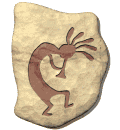 |
Rock Writing
 |
Even
though the navigational button that probably brought you to this page says
"Rock Art," this term is a misnomer. The ancient imagery archived
here is not "art" in the sense that contemporary Western culture
considers it. Petro-pictography ("rock-picture-writing"), paleography,
or even epigraphy might be more correct. Whatever one calls these signifiers,
they certainly are not art for art's sake. Instead they are a form of writing
with its own idiosyncratic grammar and usage. For instance, the Hopi word
tutuveni refers to petroglyphs (rock carvings) or pictographs (rock
paintings); however, the same word also denotes books, magazines, newspapers,
or any written material. This dual designation clearly puts the form of communication
in the same conceptual realm as the Egyptian or Mayan hieroglyph and the Chinese
ideogram.
"In most works concerned with these mysterious markings, the term rock
writing is seldom applied to them, in spite of the fact that this is the
very term the Indians themselves have always used, and would thus seem to
be the most appropriate one.... This omission is due largely to the fact that
most scholars have never accepted the premise that these markings were indeed
writing. The existence in the languages of many Indian tribes of a
word for writing (in the sense of recording information for others
to read) proves, at least that picture writing was long accepted as writing
by the Indian. And who but the American Indian himself is more qualified to
say whether it is or is not?"
LaVan Martineau
The Rocks Begin to Speak
(Las Vegas: KC Publications, Inc. 1994,1973)
"Recent theories for the study of rock art and other archaeological materials
have emphasized the roles played by context and symbolism. It has been proposed
that symbols such as rock art images are most likely to be meaningful when
examined within the contexts of time, place, culture, and society and with
the knowledge that symbolism is part of information exchange, communication
systems, and acts to express and reinforce group identities."
Sally Cole
Legacy On Stone: Rock Art of the Colorado Plateau and Four Corners Region
(Boulder, Colorado: Johnson Books, 1995, 1990)
"These images pecked into or painted on stone are a valuable component
of the archaeological record-- graphic images that often derive from the various
aspects of prehistoric cosmologies and mythic systems. Some prehistoric ideologies
of the Southwest have been carried into the ethnographic present by the modern
descendants of the prehistoric peoples, but other such systems, with the exception
of what can be learned through the visual imagery of the petroglyphs and rock
paintings, have been almost totally lost. Rock art, then, is an important
means of reaching some understanding of the sacred dimension and certain related
practices of the prehistoric period."
Polly Schaafsma
Indian Rock Art of the Southwest
(Santa Fe: School of American Research, 1995, 1980)
Palatki Pictographs
(Arizona)
V
Bar V Ranch (Arizona)
Petroglyph National Monument
(New Mexico)